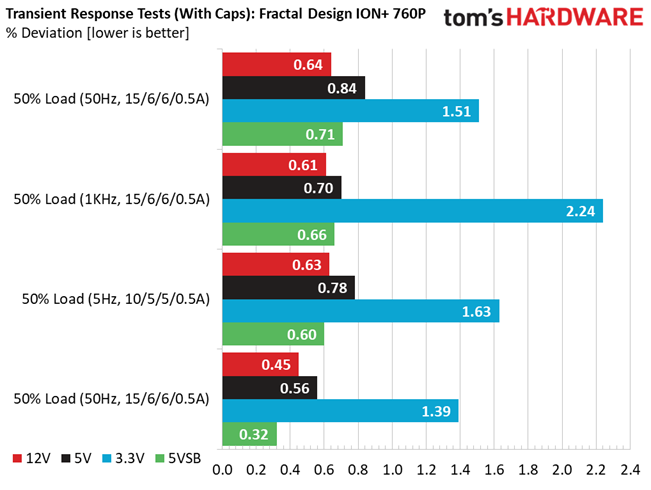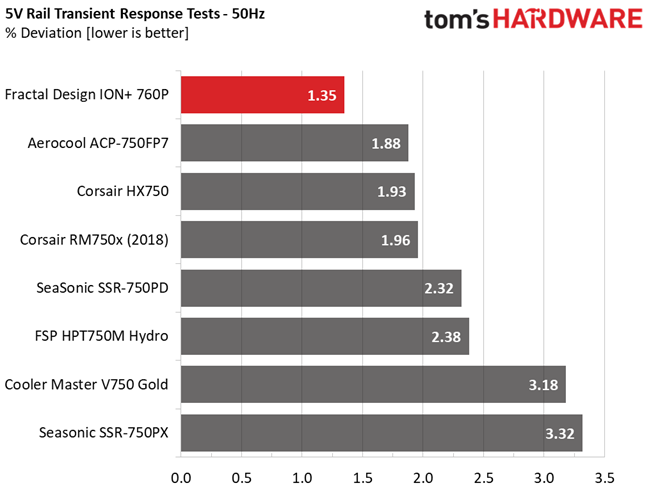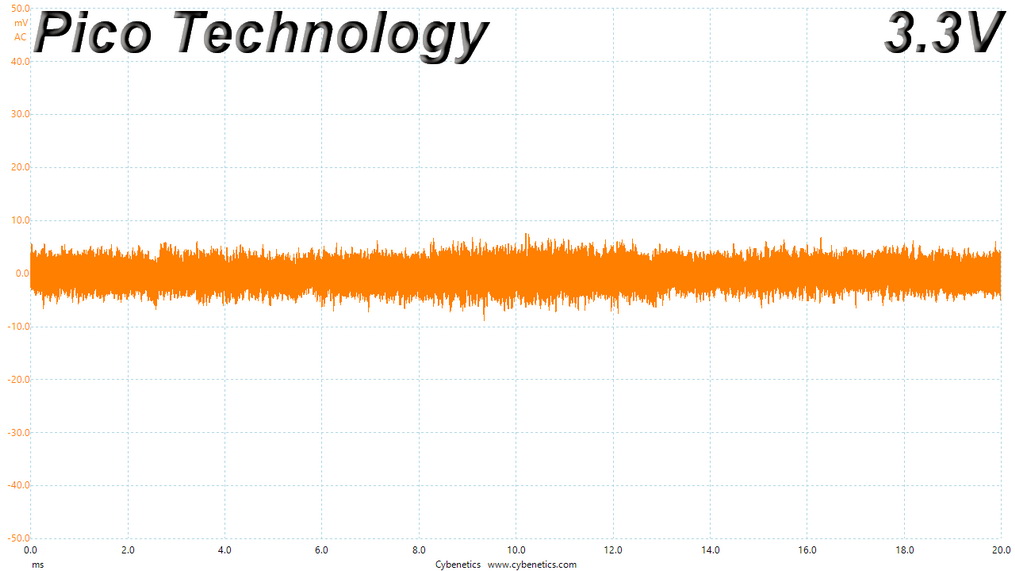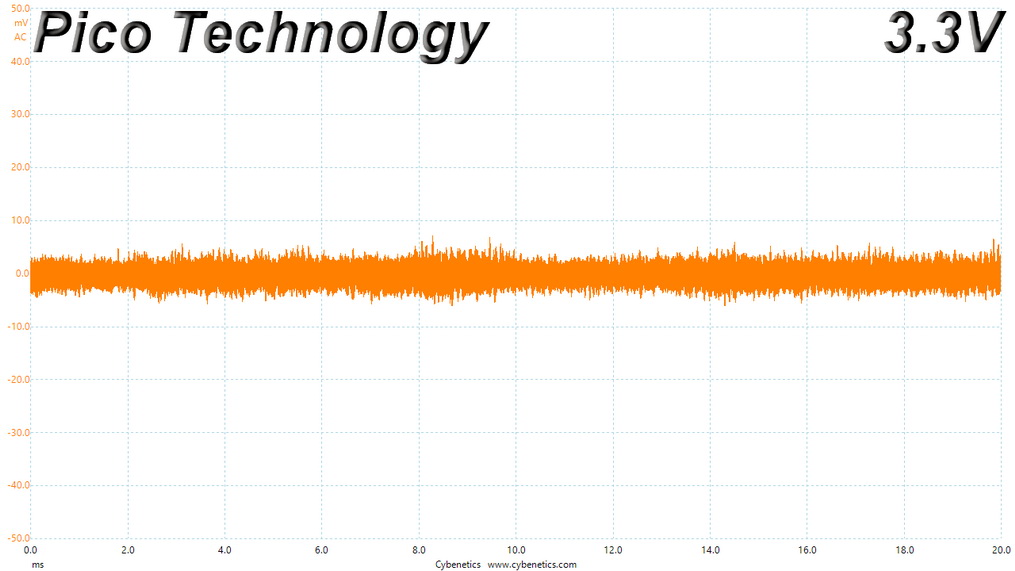Why you can trust Tom's Hardware
Advanced Transient Response Tests
For details about our transient response testing, please click here.
In the real world, power supplies are always working with loads that change. It's of immense importance, then, for the PSU to keep its rails within the ATX specification's defined ranges. The smaller the deviations, the more stable your PC will be with less stress applied to its components.
We should note that the ATX spec requires capacitive loading during the transient rests, but in our methodology, we also choose to apply a worst case scenario with no additional capacitance on the rails.
Advanced Transient Response at 20% – 20ms
| Voltage | Before | After | Change | Pass/Fail |
|---|---|---|---|---|
| 12V | 12.133V | 12.001V | 1.09% | Pass |
| 5V | 5.022V | 4.950V | 1.43% | Pass |
| 3.3V | 3.308V | 3.189V | 3.60% | Pass |
| 5VSB | 4.985V | 4.910V | 1.50% | Pass |
Advanced Transient Response at 20% – 10ms
| Voltage | Before | After | Change | Pass/Fail |
|---|---|---|---|---|
| 12V | 12.132V | 12.002V | 1.07% | Pass |
| 5V | 5.021V | 4.937V | 1.67% | Pass |
| 3.3V | 3.309V | 3.203V | 3.20% | Pass |
| 5VSB | 4.984V | 4.899V | 1.71% | Pass |
Advanced Transient Response at 20% – 1ms
| Voltage | Before | After | Change | Pass/Fail |
|---|---|---|---|---|
| 12V | 12.133V | 12.035V | 0.81% | Pass |
| 5V | 5.022V | 4.944V | 1.55% | Pass |
| 3.3V | 3.309V | 3.197V | 3.38% | Pass |
| 5VSB | 4.985V | 4.933V | 1.04% | Pass |
Advanced Transient Response at 50% – 20ms
| Voltage | Before | After | Change | Pass/Fail |
|---|---|---|---|---|
| 12V | 12.108V | 11.983V | 1.03% | Pass |
| 5V | 5.017V | 4.954V | 1.26% | Pass |
| 3.3V | 3.302V | 3.172V | 3.94% | Pass |
| 5VSB | 4.962V | 4.900V | 1.25% | Pass |
Advanced Transient Response at 50% – 10ms
| Voltage | Before | After | Change | Pass/Fail |
|---|---|---|---|---|
| 12V | 12.106V | 11.997V | 0.90% | Pass |
| 5V | 5.017V | 4.941V | 1.51% | Pass |
| 3.3V | 3.302V | 3.180V | 3.69% | Pass |
| 5VSB | 4.962V | 4.887V | 1.51% | Pass |
Advanced Transient Response at 50% – 1ms
| Voltage | Before | After | Change | Pass/Fail |
|---|---|---|---|---|
| 12V | 12.108V | 11.962V | 1.21% | Pass |
| 5V | 5.017V | 4.931V | 1.71% | Pass |
| 3.3V | 3.302V | 3.194V | 3.27% | Pass |
| 5VSB | 4.963V | 4.885V | 1.57% | Pass |

Results 25-29: Transient Response







The transient response is satisfactory on the 12V, 3.3V and 5VSB rails and very good at 5V.
Turn-On Transient Tests
In the next set of tests, we measure the PSU's response in simpler transient load scenarios — during its power-on phase. Ideally, we don't want to see any voltage overshoots or spikes since those put a lot of stress on the DC-DC converters of installed components.

Turn-On Transient Response Scope Shots


There is a small step in the 5VSB rail's waveform and small voltage overshoots at 12. That's decent performance, overall.
Ripple Measurements
Ripple represent the AC fluctuations (periodic) and noise (random) found in the PSU's DC rails. This phenomenon significantly decreases the capacitors' lifespan because it causes them to run hotter. A 10-degree Celsius increase can cut into a cap's useful life by 50%. Ripple also plays an important role in overall system stability, especially when overclocking is involved.
Get Tom's Hardware's best news and in-depth reviews, straight to your inbox.
The ripple limits, according to the ATX specification, are 120mV (+12V) and 50mV (5V, 3.3V, and 5VSB).
| Test | 12V | 5V | 3.3V | 5VSB | Pass/Fail |
| 10% Load | 12.8 mV | 9.3 mV | 11.5 mV | 11.9 mV | Pass |
| 20% Load | 13.5 mV | 10.3 mV | 13.2 mV | 14.7 mV | Pass |
| 30% Load | 15.2 mV | 11.4 mV | 13.2 mV | 14.7 mV | Pass |
| 40% Load | 16.2 mV | 11.8 mV | 14.1 mV | 16.5 mV | Pass |
| 50% Load | 16.3 mV | 12.5 mV | 15.0 mV | 17.8 mV | Pass |
| 60% Load | 18.4 mV | 12.8 mV | 14.3 mV | 17.5 mV | Pass |
| 70% Load | 18.2 mV | 12.8 mV | 15.1 mV | 19.2 mV | Pass |
| 80% Load | 19.4 mV | 12.5 mV | 15.3 mV | 20.4 mV | Pass |
| 90% Load | 20.8 mV | 13.4 mV | 14.9 mV | 20.8 mV | Pass |
| 100% Load | 26.5 mV | 13.8 mV | 17.1 mV | 23.3 mV | Pass |
| 110% Load | 27.7 mV | 15.2 mV | 17.8 mV | 24.0 mV | Pass |
| Crossload 1 | 16.0 mV | 11.2 mV | 14.3 mV | 14.4 mV | Pass |
| Crossload 2 | 25.6 mV | 13.8 mV | 17.0 mV | 22.1 mV | Pass |

Results 30-33: Ripple Suppression



The ripple suppression is good on all rails, although the competition achieves better performance here. The majority of manufacturers pay extra attention to ripple suppression, so the performance in this section has reached amazingly high levels. We often meet PSUs with lower than 20mV ripple at 12V and below 15mV on the minor rails, under full load.
Ripple At Full Load

Ripple Full Load Scope Shots



Ripple At 110% Load

Ripple 110% Load Scope Shots



Ripple At Cross-Load 1

Ripple CL1 Load Scope Shots



Ripple At Cross-Load 2

Ripple CL2 Load Scope Shots



EMC Pre-Compliance Testing – Average & Quasi-Peak EMI Detector Results
Electromagnetic Compatibility (EMC) is the ability of a device to operate properly in its environment without disrupting the proper operation of other nearby devices.
Electromagnetic Interference (EMI) is the electromagnetic energy a device emits, and it can cause problems in other nearby devices if too high. For example, it can be the cause of increased static noise in your headphones or/and speakers.
There are some spurs with the average EMI detector. On the contrary, with the QP detector, which is more accurate, there are no problems.
MORE: Best Power Supplies
MORE: How We Test Power Supplies
MORE: All Power Supply Content
Current page: Transient Response Tests, Timing Tests, Ripple Measurements and EMC Pre-Compliance Testing
Prev Page Protection Features, DC Power Sequencing, Cross-Load Tests and Infrared Images Next Page Performance, Noise and Efficiency
Aris Mpitziopoulos is a contributing editor at Tom's Hardware, covering PSUs.
-
shadyj Reply
Hello,Admin said:The Ion+ 760P from Fractal Design offers good performance and silent operation at a decent price.
Fractal Design Ion+ Platinum 760W Power Supply Review : Read more
I just want to thank Tom's Hardware for such in-depth PSU reviews like this with serious measurements. I will admit most of the metrics in the review go over my head, but the reviewer does provide guidance as to how those measurements rank the product under review. I know this is not easy to do since I review products that have measurable performance that can get highly technical, but I try to provide commentary as to the meaning of the test results. These objective results are so much more valuable than some "influencer's" subjective experience on youtube or some other low data review. This really helps us who aren't electrical engineers make a slightly more informed purchase with more confidence.
Thanks! -
NoFaultius Interesting timing on your article. I just RMA'd this power supply today. It worked great for 10 months, then started causing random reboots. While it worked, it worked great. Silent and strong. So far, they have been good with the RMA process. They emailed me a label to send them the defective unit back. Apparently they will send me a replacement once they get it and run some tests.Reply
